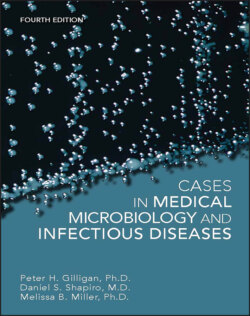Читать книгу Cases in Medical Microbiology and Infectious Diseases - Melissa B. Miller - Страница 36
CASE 1
ОглавлениеThe patient was a 19-year-old female with a history of a urinary tract infection (UTI) 4 months prior to admission for which she was treated with oral ampicillin without complications. Five days prior to this admission she began to note nausea without vomiting. One day later she developed left flank pain, fevers, and chills and noted increased urinary frequency. She noted foul-smelling urine on the day prior to admission. She presented with a temperature of 38.8°C, and physical examination showed left costovertebral angle tenderness. Urinalysis of a clean-catch urine sample was notable for >50 white blood cells per high-power field, 3 to 10 red blood cells per high-power field, and 3+ bacteria. Urine culture was subsequently positive for >105 CFU of an organism per ml (seen growing on culture in Fig. 1.1 [sheep blood agar] and Fig. 1.2 [MacConkey agar]). Note that the organism is beta-hemolytic.
1 1. What do the urinalysis findings indicate? Explain your answer.
2 2. Why were the numbers of organisms in her urine quantitated on culture? How would you interpret the culture results in this case?
3 3. Which Gram-negative rods are lactose fermenters? Which one is also often beta-hemolytic?
4 4. This bacterium was resistant to ampicillin. What in this patient’s history might explain this observation? Multidrug-resistant strains of this organism are beginning to be seen as an important cause of UTI. Describe the mechanism of resistance that these organisms most likely will have.
5 5. UTIs are more frequent in women than men. Why?
6 6. Did this woman have cystitis or pyelonephritis? Why is it important to differentiate between the two?
7 7. Briefly explain the evolution of the organism causing this infection in terms of its ability to infect the urinary tract. What virulence factors have been shown to play a pathogenic role in this infection?
Figure 1.1
Figure 1.2
